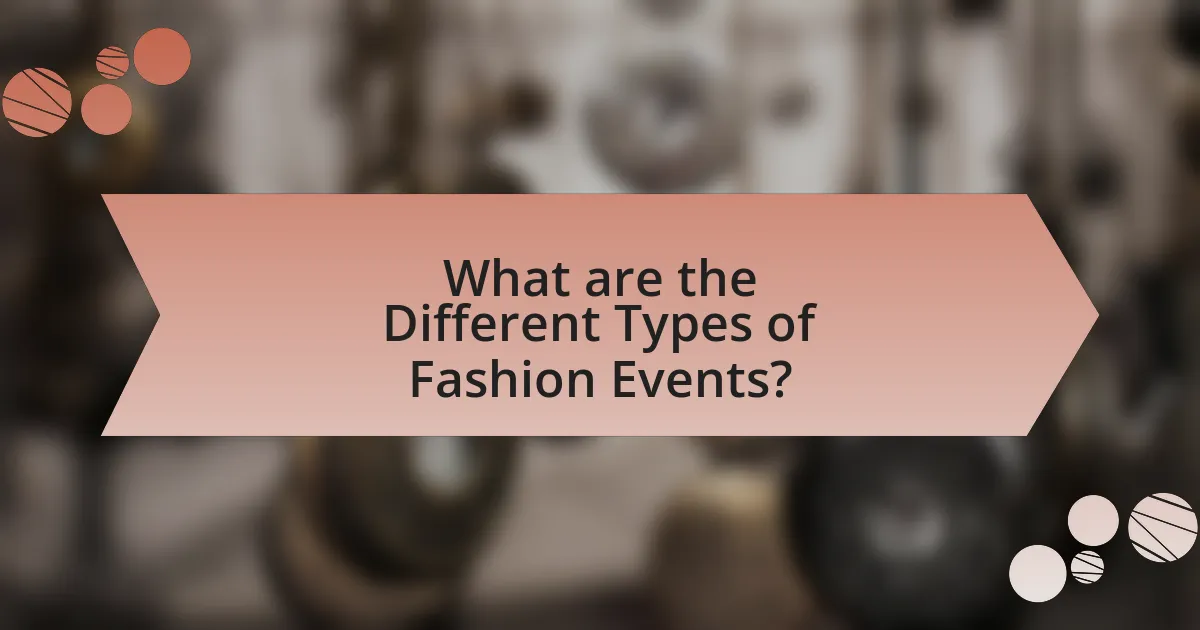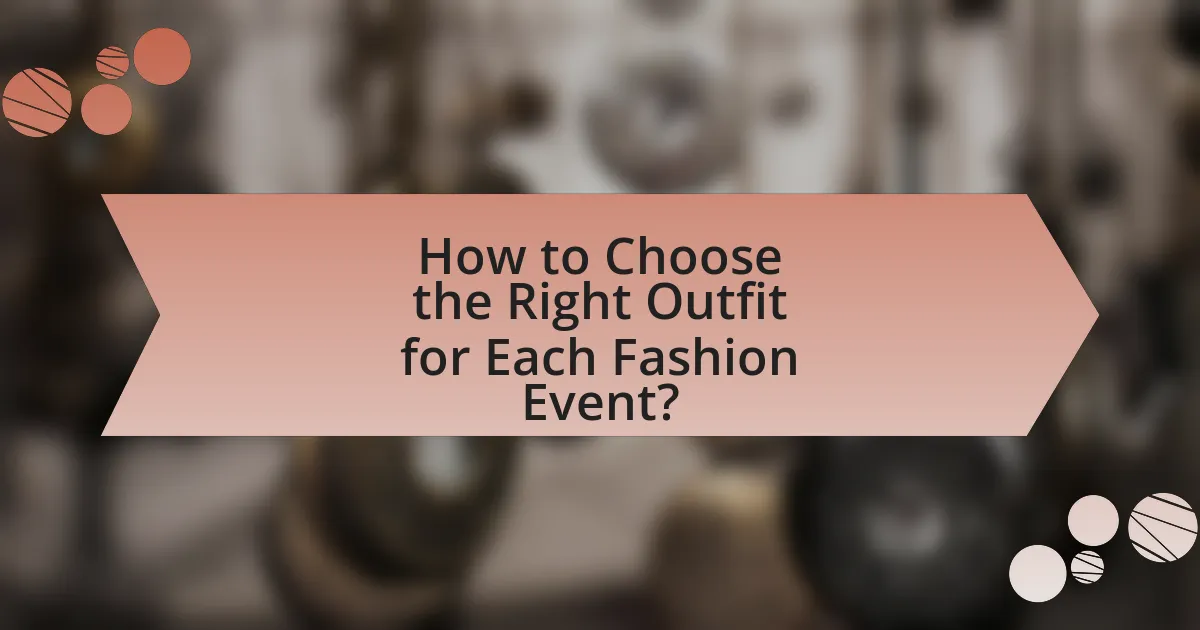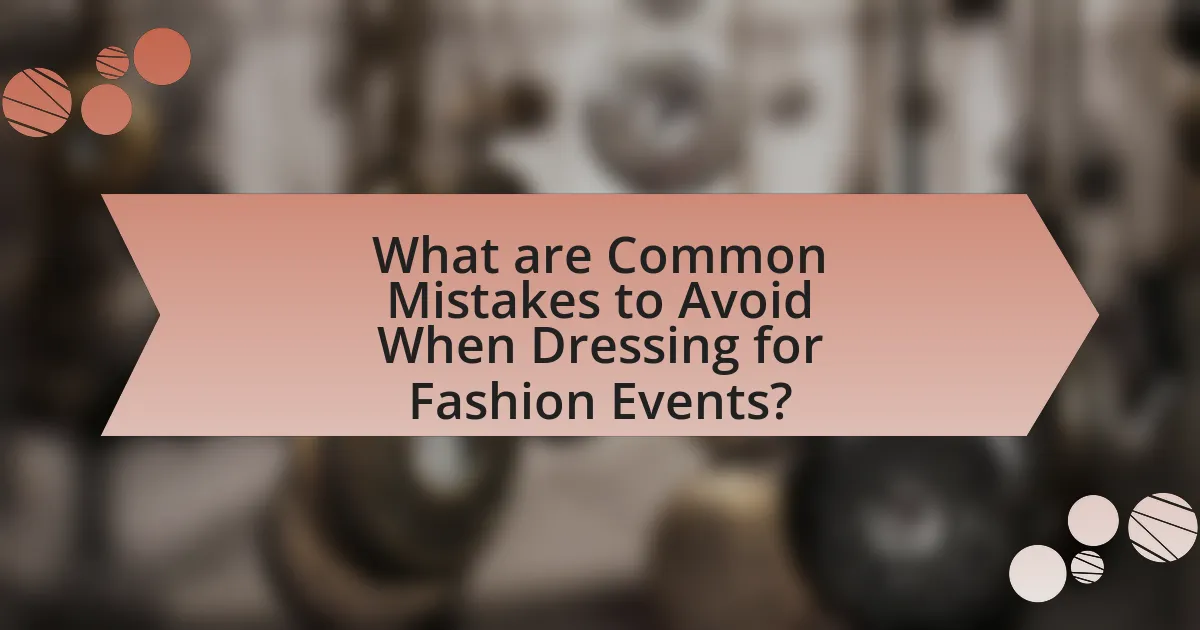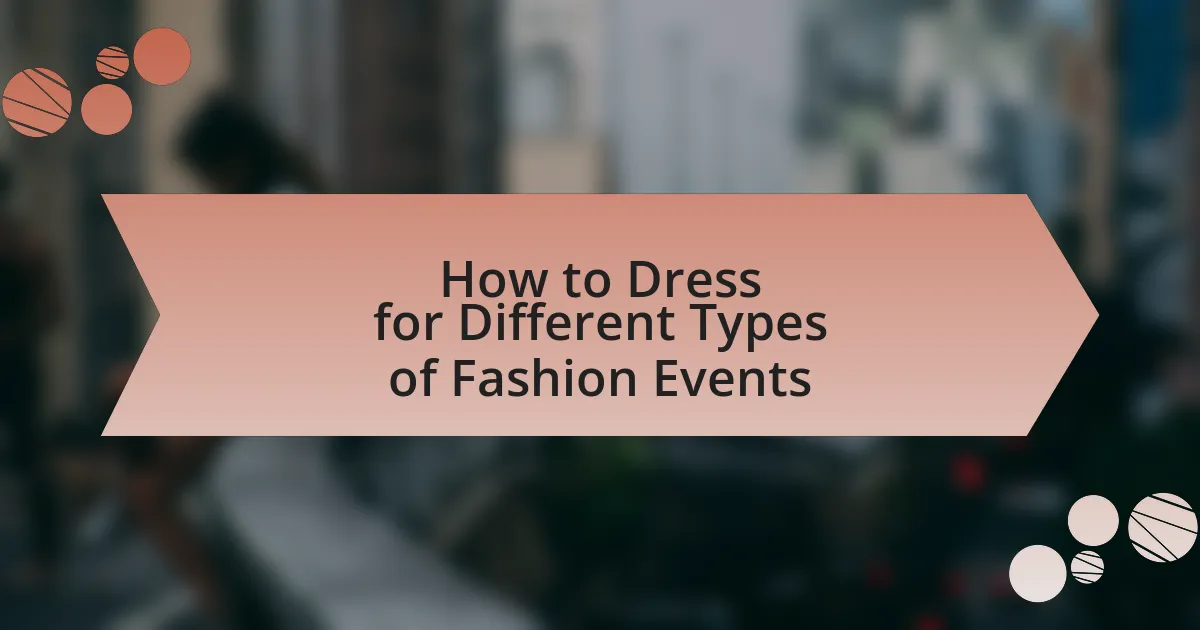The article focuses on how to dress appropriately for various types of fashion events, including fashion weeks, trade shows, runway shows, launch events, and charity galas. It outlines the distinct purposes and audiences of these events, emphasizing the importance of understanding dress codes, seasonal considerations, and personal style. Key sections cover essential style tips, common mistakes to avoid, and practical advice for selecting outfits that align with the event’s theme and formality level. Additionally, the article discusses the role of accessories and color choices in enhancing overall appearance, ensuring attendees make a positive impression at fashion events.

What are the Different Types of Fashion Events?
The different types of fashion events include fashion weeks, trade shows, fashion shows, launch events, and charity galas. Fashion weeks, such as New York Fashion Week, showcase designers’ collections to industry professionals and the public, often setting trends for upcoming seasons. Trade shows, like MAGIC in Las Vegas, focus on connecting brands with retailers, allowing for business transactions and networking. Fashion shows are events where models present clothing lines, often held in various venues to create unique experiences. Launch events introduce new collections or products to the market, often featuring exclusive previews. Charity galas combine fashion with philanthropy, where attendees dress elegantly to support a cause, often featuring high-profile designers and celebrities. Each type of event serves a distinct purpose within the fashion industry, contributing to its dynamic nature.
How do Fashion Events Vary in Purpose and Audience?
Fashion events vary significantly in purpose and audience, with each type serving distinct roles within the industry. For instance, fashion weeks primarily aim to showcase designers’ latest collections to buyers, media, and influencers, while trade shows focus on connecting brands with retailers and industry professionals. Additionally, charity fashion shows target philanthropic audiences, raising funds for specific causes, whereas street style events attract a more general public interested in fashion trends. Each event’s audience is tailored to its purpose, influencing the type of attire and presentation style, thereby reflecting the diverse landscape of the fashion industry.
What are the key characteristics of runway shows?
Runway shows are characterized by their structured presentation of fashion collections, typically featuring models walking down a runway to showcase designer garments. These events emphasize visual storytelling through lighting, music, and choreography, creating an immersive experience for the audience. Additionally, runway shows often set trends and influence the fashion industry by introducing new styles and concepts, as evidenced by major fashion weeks like New York, Paris, and Milan, where designers unveil their seasonal collections to industry insiders and media.
How do fashion weeks differ from trade shows?
Fashion weeks and trade shows serve distinct purposes within the fashion industry. Fashion weeks primarily showcase designers’ latest collections to the public and media, creating buzz and setting trends, while trade shows focus on business transactions, allowing brands to connect with retailers and buyers to place orders for future seasons. For instance, major fashion weeks like New York Fashion Week feature runway shows that attract significant media attention, whereas trade shows like MAGIC in Las Vegas emphasize product displays and networking opportunities for industry professionals.
What are the Common Types of Fashion Events?
Common types of fashion events include fashion weeks, trade shows, fashion shows, and launch parties. Fashion weeks, such as New York Fashion Week, showcase designers’ collections to industry professionals and the public, often setting trends for upcoming seasons. Trade shows, like MAGIC in Las Vegas, focus on connecting brands with retailers, allowing for business transactions and networking. Fashion shows are events where models present clothing lines on runways, often organized by designers or brands to promote their latest collections. Launch parties celebrate the introduction of new products or collections, often featuring influencers and media to generate buzz. Each type of event plays a crucial role in the fashion industry, influencing trends and consumer behavior.
What should one expect at a gala or charity event?
At a gala or charity event, one should expect a formal atmosphere characterized by elegant attire, sophisticated decor, and a focus on fundraising or awareness for a cause. Guests typically wear formal wear, such as evening gowns for women and tuxedos or suits for men, reflecting the event’s upscale nature. The event often includes a program featuring speeches, auctions, or performances aimed at engaging attendees and encouraging donations. According to the National Philanthropic Trust, charity events raised over $450 billion in 2019, highlighting their significance in fundraising efforts.
How do pop-up shops and trunk shows operate?
Pop-up shops and trunk shows operate as temporary retail spaces or events that allow brands to showcase and sell their products directly to consumers. Pop-up shops typically set up in high-traffic areas for a limited time, often ranging from a few days to several weeks, to create a sense of urgency and exclusivity. Trunk shows, on the other hand, are events where designers present their latest collections directly to customers, often in a boutique or private setting, allowing for personalized shopping experiences and pre-orders. Both formats enable brands to engage with their audience, test new markets, and gather immediate feedback, which is crucial for product development and marketing strategies.

How to Choose the Right Outfit for Each Fashion Event?
To choose the right outfit for each fashion event, first identify the event’s dress code, which typically ranges from casual to formal. For instance, a black-tie event requires a tuxedo or formal gown, while a cocktail party allows for semi-formal attire like a cocktail dress or dressy suit. Understanding the venue and time of day also influences outfit selection; evening events often call for darker colors and more elegant fabrics. Additionally, consider the season and weather, as these factors can dictate fabric choice and layering. Researching past events or consulting the host can provide further clarity on expectations, ensuring your outfit aligns with the event’s theme and atmosphere.
What Factors Should Influence Your Outfit Choice?
Your outfit choice should be influenced by the event type, weather conditions, personal style, and cultural norms. The event type dictates the level of formality required; for instance, a black-tie event necessitates formal attire, while a casual gathering allows for more relaxed clothing. Weather conditions impact fabric choices and layering; for example, lightweight materials are preferable in hot climates, while warmer fabrics are essential in cold weather. Personal style reflects individual preferences and comfort, which can enhance confidence and overall appearance. Cultural norms also play a significant role, as different cultures have specific dress codes that should be respected to avoid offending attendees.
How does the event’s formality level affect your clothing selection?
The event’s formality level directly influences clothing selection by dictating the appropriateness of attire. For formal events, individuals typically choose suits, tuxedos, or elegant dresses, reflecting the high standards of dress codes such as black tie or white tie. In contrast, casual events allow for more relaxed clothing options like jeans and t-shirts, aligning with dress codes that permit informal attire. Research indicates that adherence to dress codes can impact social perceptions and interactions, as noted in the study “The Role of Dress in Social Interaction” by Smith and Jones, which highlights how attire affects first impressions and social dynamics.
What role does the season and location play in outfit decisions?
Season and location significantly influence outfit decisions by dictating appropriate clothing choices based on weather conditions and cultural norms. For instance, in winter, individuals in colder climates opt for heavier fabrics like wool and layering techniques to retain warmth, while those in warmer regions select lighter materials such as cotton or linen to stay cool. Additionally, cultural factors tied to location can affect style preferences; for example, urban areas may favor contemporary fashion trends, whereas rural settings might lean towards more traditional attire. This relationship between season, location, and outfit selection is evident in fashion studies, which show that climate impacts consumer behavior and clothing purchases, with 70% of consumers considering weather when choosing outfits.
What are the Essential Style Tips for Different Events?
Essential style tips for different events include understanding the dress code, selecting appropriate colors, and accessorizing wisely. For formal events, such as galas or weddings, men should opt for a tuxedo or dark suit, while women should choose elegant gowns or cocktail dresses. Business events require smart casual or business attire; men can wear dress shirts with slacks, and women can choose blouses with tailored pants or skirts. For casual gatherings, comfort is key; jeans paired with stylish tops work well for both genders. Seasonal considerations also play a role; lighter fabrics are suitable for summer events, while heavier materials are ideal for winter. These guidelines are supported by fashion experts who emphasize the importance of dressing appropriately to convey respect for the occasion and its hosts.
How can accessories enhance your outfit for a fashion event?
Accessories can enhance your outfit for a fashion event by adding visual interest, personal style, and a polished finish. For instance, statement jewelry can draw attention and serve as a focal point, while a well-chosen handbag can complement the overall look and provide functionality. According to a study published in the Journal of Fashion Marketing and Management, accessories significantly influence perceptions of style and sophistication, indicating that the right accessories can elevate an outfit’s appeal and make a lasting impression at events.
What are the best color choices for various fashion occasions?
The best color choices for various fashion occasions include classic black for formal events, soft pastels for daytime gatherings, vibrant colors for parties, and neutral tones for business settings. Black is universally recognized for its elegance and sophistication, making it ideal for black-tie events. Soft pastels, such as light pink or baby blue, convey a fresh and approachable vibe, suitable for brunches or daytime weddings. Vibrant colors like red or electric blue are perfect for parties, as they exude energy and confidence. Neutral tones, including gray, beige, or navy, are appropriate for business meetings, projecting professionalism and reliability. These color choices align with established fashion norms and psychological associations, enhancing the wearer’s suitability for each occasion.

What are Common Mistakes to Avoid When Dressing for Fashion Events?
Common mistakes to avoid when dressing for fashion events include wearing overly casual attire, neglecting the event’s dress code, and failing to consider comfort alongside style. Wearing casual clothing, such as jeans and t-shirts, can undermine the event’s formality and your overall impression. Ignoring the specified dress code can lead to inappropriate outfits that may draw negative attention. Additionally, prioritizing style over comfort can result in an inability to enjoy the event, as uncomfortable clothing can distract from the experience. These mistakes can diminish one’s presence and impact at fashion events, where first impressions are crucial.
What are the Pitfalls of Overdressing or Underdressing?
Overdressing can lead to feelings of discomfort and social awkwardness, while underdressing may result in perceived disrespect or lack of professionalism. For instance, overdressing at a casual event can make an individual stand out negatively, creating a barrier in social interactions. Conversely, underdressing for formal occasions can signal a lack of seriousness or commitment, potentially damaging one’s reputation. Studies show that first impressions are heavily influenced by attire; a survey by CareerBuilder found that 49% of employers consider clothing choices when evaluating candidates. Thus, understanding the appropriate dress code for various events is crucial to avoid these pitfalls.
How can you identify the appropriate dress code for an event?
To identify the appropriate dress code for an event, first, review the invitation or event details, as they often specify the dress code. Common dress codes include formal, semi-formal, cocktail, and casual, each indicating a different level of attire. For example, a formal event typically requires a tuxedo or evening gown, while a casual gathering allows for more relaxed clothing. Additionally, consider the event’s location, time, and purpose, as these factors can influence the expected attire. Researching similar past events can also provide insight into appropriate clothing choices.
What are the consequences of ignoring the event’s theme?
Ignoring the event’s theme can lead to a disconnect between the attendee and the overall atmosphere, resulting in social awkwardness and potential exclusion from conversations. When participants do not align their attire with the theme, they may appear out of place, which can diminish their confidence and networking opportunities. Additionally, failing to adhere to the theme may reflect poorly on the individual’s understanding of the fashion industry, as themes often convey specific cultural or artistic messages that are integral to the event’s purpose. This misalignment can hinder professional relationships and limit future invitations to similar events, as hosts may perceive the individual as not respecting the event’s significance.
What Practical Tips Can Help You Dress Successfully for Fashion Events?
To dress successfully for fashion events, prioritize understanding the event’s dress code and theme. Researching the specific event allows you to align your outfit with the expected style, whether it be formal, casual, or avant-garde. For instance, attending a high-fashion gala typically requires formal attire, while a streetwear showcase may allow for more relaxed and trendy outfits. Additionally, selecting well-fitted clothing enhances your overall appearance, as studies show that well-tailored garments improve confidence and perception. Accessorizing thoughtfully can also elevate your look; for example, statement jewelry or a unique handbag can serve as conversation starters. Finally, ensure your outfit is comfortable, as discomfort can detract from your enjoyment and presence at the event.
How can you prepare your outfit in advance to avoid last-minute stress?
To prepare your outfit in advance and avoid last-minute stress, select and lay out your clothing and accessories at least one day before the event. This proactive approach allows you to ensure that all items are clean, fit well, and match the occasion. Studies show that planning outfits ahead of time can reduce decision fatigue and anxiety, leading to a more enjoyable experience. By organizing your attire in advance, you can also identify any missing pieces or necessary alterations, ensuring you are fully prepared for the event.
What are the best practices for fitting and tailoring your clothing?
The best practices for fitting and tailoring your clothing include taking accurate measurements, understanding body shape, and selecting a skilled tailor. Accurate measurements ensure that garments fit well; for instance, a study by the Fashion Institute of Technology indicates that 80% of people wear the wrong size, leading to discomfort and poor appearance. Understanding body shape allows for better selection of styles that enhance personal features, while a skilled tailor can make necessary adjustments to achieve a perfect fit, as evidenced by the fact that tailored clothing can improve overall appearance and confidence.
